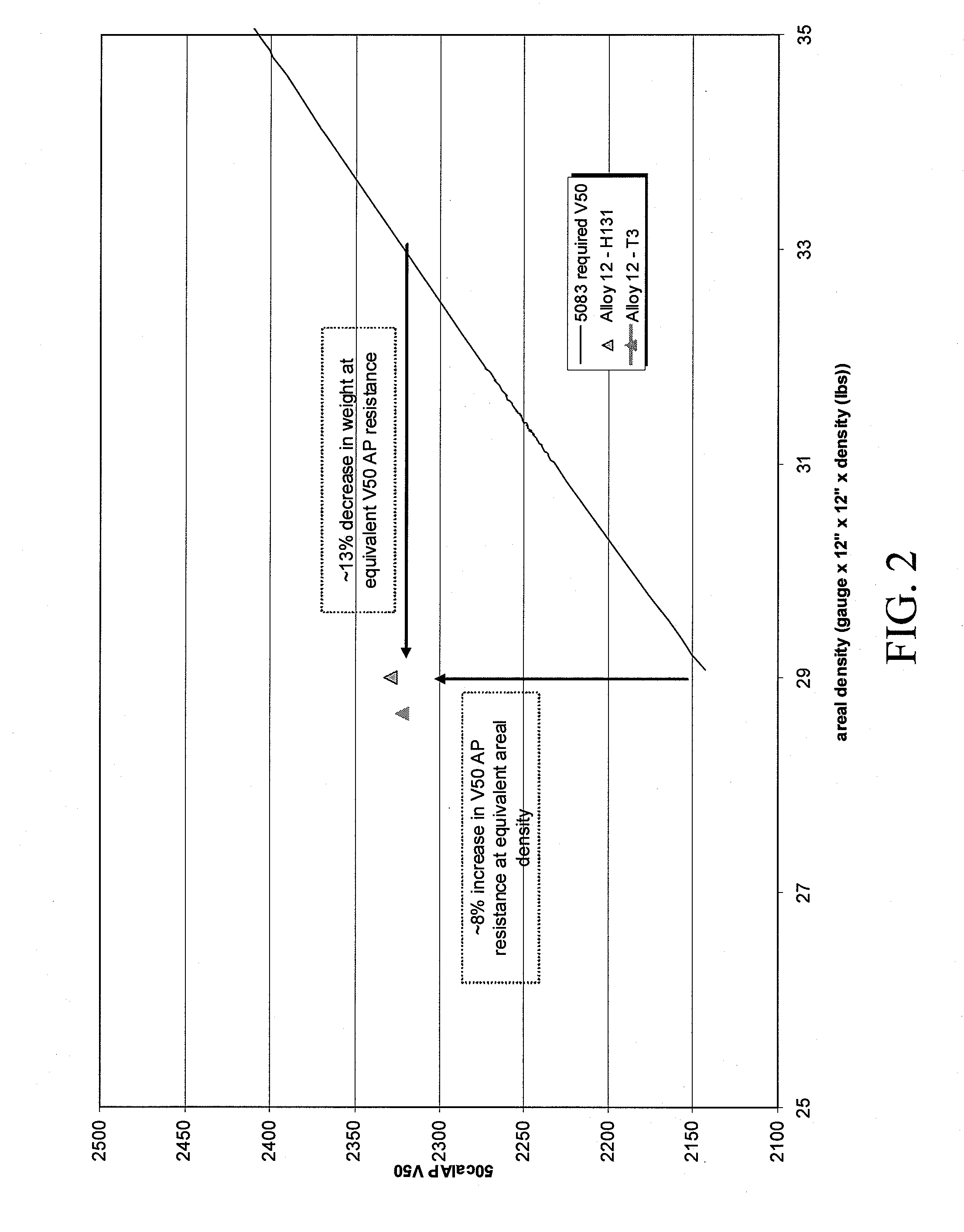5xxx aluminum alloys and wrought aluminum alloy products made therefrom
- Summary
- Abstract
- Description
- Claims
- Application Information
AI Technical Summary
Benefits of technology
Problems solved by technology
Method used
Image
Examples
example 1
[0068]Ten book mold castings are produced, and the constituents of each casting are listed in Table 2, below (all values in weight percent), the balance being aluminum and unavoidable impurities (all alloys contained ≦0.05 wt. % each of Fe and Si). A 3:1 TiB2 grain refiner addition was made for all casts, which were fluxed for five minutes prior to casting.
TABLE 2Composition of Experimental 5xxx Cast AlloysEx.AlloyMgCuMnZnScZrTi15.06—0.740.420.0850.0820.01525.54—0.740.420.0990.0760.01436.02—0.750.430.0880.090.01544.97—0.940.420.0930.0880.01455.110.0020.750.660.0910.0880.01465.080.20.750.480.0840.0820.01475.070.370.740.430.0790.080.01785.090.560.730.430.0920.0830.01495.510.360.730.430.0790.0840.019105.550.370.940.430.0760.0860.014
[0069]After casting, each book mold has the approximate dimension of 32 mm (thick)×70 mm (width)×150 mm (length). The castings are homogenized as follows:
[0070]Ramp to 260° C. (500° F.) in 4 hrs
[0071]Soak at 260° C. (500° F.)+ / −2° C. (5° F.) for 5 hrs
[0072]R...
example 2
[0087]Two experimental alloys are direct chill cast into ingots. The constituents of each alloy is provided in Table 4 below (all values in weight percent), the balance being aluminum and unavoidable impurities (all alloys contained ≦0.05 wt. % each of Fe and Si).
TABLE 4Composition of Experimental 5xxx Cast AlloysEx. AlloyMgCuMnZnCrZrTiSiFe115.0200.2000.585—0.0880.1100.0190.0270.048125.0200.4920.56—0.0840.1010.0190.0270.043
[0088]The alloy 11 ingot experienced cracking and could not be rolled via industrial scale machinery. Thus, uncracked portions of the alloy 11 ingot were removed for rolling via lab scale machinery. A portion of the alloy 12 ingot was also removed for testing at the lab scale for comparative purposes. These portions had dimensions of 10″×12″×20″.
Lab Scale—Alloys 11 and 12
[0089]Both the alloy 11 and 12 lab scale portions are processed to a T3 temper in about 1″ gauge, per below. The portions sliced from the alloy 11 and alloy 12 ingots are homogenized at 860° F. fo...
example 3
[0103]Alloy 12, in the H131 and T3 tempers, is subjected to ballistics testing, the results of which are illustrated in FIGS. 1 and 2. With respect to FSP performance (FIG. 1), both tempers achieve improved ballistics performance, achieving about a 10% reduction in weight at similar V50 armor piercing performance relative to prior art alloy 5083 minimums, or, stated differently, an improved V50 performance at an equivalent areal density relative to prior art alloy minimums. With respect to AP performance (FIG. 2), both alloys achieve improved ballistics performance, achieving about a 13% reduction in weight at similar V50 armor piercing performance relative to prior art alloy 5083 minimums, or, stated differently, an improved V50 performance at an equivalent areal density relative to prior art alloy minimums.
PUM
| Property | Measurement | Unit |
|---|---|---|
| Fraction | aaaaa | aaaaa |
| Fraction | aaaaa | aaaaa |
| Fraction | aaaaa | aaaaa |
Abstract
Description
Claims
Application Information
 Login to View More
Login to View More - R&D
- Intellectual Property
- Life Sciences
- Materials
- Tech Scout
- Unparalleled Data Quality
- Higher Quality Content
- 60% Fewer Hallucinations
Browse by: Latest US Patents, China's latest patents, Technical Efficacy Thesaurus, Application Domain, Technology Topic, Popular Technical Reports.
© 2025 PatSnap. All rights reserved.Legal|Privacy policy|Modern Slavery Act Transparency Statement|Sitemap|About US| Contact US: help@patsnap.com



